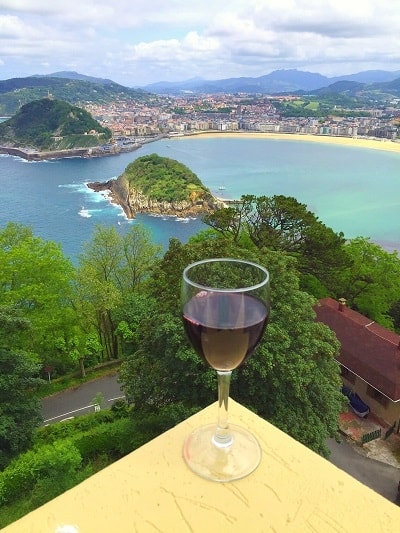For those of you who enjoy experiencing excellent wine, abundant choices of exceptional local food, rich culture, and the history of ancient civilizations, all within a manageable pace and timeframe, consider having your next travel experience in Northern Spain. My recent excursion was designed as an upscale, autonomous, self-guided vacation designed to maximize the experience within this unique culture. This 8-day luxury Spain itinerary exceeded our expectations and as a Winetraveler, I highly recommend you try it out.
Days 1 and 2: Madrid
Capitalizing on the independence of leasing a vehicle, we could fulfill the initial plan at a manageable pace. The trip began in Madrid where we spent two nights and three days staying at the esteemed five-star Weston Palace. The Weston is centrally located in downtown Madrid across the street from the world-famous Prado (Classical) and Thyssen-Bornemisza (Modern) museums, and close to the shopping district. The hotel breakfast buffet, lunch, and dinner are excellent and the accommodations are generous, immaculate, and up-to-date.
RELATED: The Best Tapas Bars To Visit in Madrid

The first day was spent getting acquainted with the surroundings and walking a large perimeter around the hotel, including the Mercado San Miguel, Puerta del Sol’s many boutiques and tapas restaurants, and shopping along the Gran Via. The evening was spent taking in Spanish culture at the Tablao Flamenco dinner/show at the Corral de la Moreria, one of the most renowned in the country. Tablao Flamenco is located in an upscale neighborhood, 20 minutes by cab from the hotel, overlooking lower Madrid.
The food is traditional Spanish (steak, pork, and fish with French fries) and included a good wine selection from both Ribera del Duero and Rioja. One should anticipate enjoying the event in tight quarters, almost family-style, but well worth the experience.

The second day should be used to enjoy the Prado and Thyssen-Bornemisza museums. Although both are different in their approach, they display many famous works of art and sculpture. After lunch at a local tapas restaurant, we walked through the Parque de Buen Retiro and later ventured on Calle Mayor, to the Palacio Real de Madrid (Royal Palace) and Catedral del Almudena, where we enjoyed a recommended informative tour of the Palace. The former family home of the Royal Family and throne of King Charles I, it is used today as a ceremonial palace and the Royals live in another nearby location.

Day 3: Rioja
On the third day, we picked up our rental car at the centrally located Estacion de Atocha train station, a five-minute cab ride from our hotel, and began our journey North into the Rioja region. We found the roadways throughout the North were well-marked and easy to navigate, but be prepared for the select tolls along the way. The first destination upon leaving Madrid, was the famous vineyard and eclectic five-star hotel at Marques de Riscal, located in the ancient city of Elciego. Marques de Riscal also includes a Michelin Star restaurant with an excellent choice of the vineyard’s top wines. The hotel, designed by Frank Gehry, is very modern with the intention of appearing as a large wine bush, accented by its waves of red, bronze and green steel structure glistening for miles in the distance. Note that Gehry also designed the art museum in Bilbao in Northern Spain.
RELATED: 22 Best Wineries To Visit in La Rioja: Everything You Need To Know About Visiting
From the hotel, it was 10 minutes to Laguardia. Here we walked around this small but fascinating town on a hill overlooking the panoramic view of the region. At this time of year, the hills were a lush green and populated with many vineyards deep into the distance. After a quick tapas lunch, we drove back to our hotel and walked the grounds and relaxed before a late-night, four-course dinner at the Michelin-rated restaurant at the Marques de Riscal hotel. The next morning, we took a formal tour of the vineyard with our hostess, Franchesca, who did an excellent job explaining the history and evolution of the vineyard along with a detailed description of the wine-making process. Make sure you stay for the wine tasting and visit the wine shop for items to bring back home to friends and family.
Winetraveler Tip: Of note, Monday and Tuesdays in this part of the world are not the time to see the local people. After working a long weekend, they take these days off (including the Michelin-star Chef), and unfortunately, many establishments will be closed – so check in advance.

Days 4 to 7: San Sebastián
The next destination was San Sebastian. The 1,000-year-old capital of the Basque Region (“Donostia” in the local Euskara language) is located in the northeastern-most corner of Spain, just inside the French border on the Cantabrian Sea. This city has approximately 200,000 residents and doubles in population during the summer months. Going off-season is highly recommended to avoid the high season’s extreme congestion. This City by the Sea is surrounded by the beautiful and dramatic Pyrenees mountain range, which soar high above the Atlantic Ocean. San Sebastian is a prosperous and beautiful seaside community with a great waterfront promenade running the length of the Bay of La Concha.
RELATED: Learn More About Spain’s Stunning Basque Country
San Sebastian is known as the “Food Capital of Spain” where many aspiring chefs promote their trade and are attempting to develop their brand recognition. The Old Town (Parte Vieja) has many Baroque and Gothic churches, plazas, shops, and restaurants where you can enjoy a tapas-style experience called Pintxos (Peen-chohs). There are many to choose from, explore and enjoy. The Old City captures the charm of its historical roots with plazas, shops, restaurants, and interesting Baroque and Gothic churches, all bordering the inner harbor which also houses the San Sebastian Aquarium, something worth visiting.
San Sebastian also has an evolving New City which is more modern and populated with more progressive shops and restaurants. Taking an excursion to Monte Urgull is a must and overlooks the Cantabrian Sea and La Concha Beach. It is well worth the hike or ride up to observe the panoramic vistas of this beautiful city. We took advantage of our centrally located Five-Star hotel, the Maria Cristina, by walking each day to different parts of San Sebastian in the three nights and four days we stayed in this wonderful location. One must experience at a minimum the walk along the boardwalk by the emerald sea, climbing Monte Urgull to see the Christ overlooking the City, the surprisingly impressive Marine Aquarium, exploring the narrow streets and quaint cafes in the Old Quarter and experience the breadth of food and wine options, which are generous.
Day 6: Day Trip to Castro Urdiales
San Sebastian also served as the base for exploring other towns west along the beautiful Northern Coast of Spain, including the ancient Roman fishing village of Castro Urdiales, home of my mother’s family heritage. This charming community is approximately two and a half hours west of San Sebastian and a perfect one-day excursion. The fishing pier and harbor have not changed in centuries and the ancient cathedral and castle overlook the port and the town. Quaint shops and Pintxos locations abound, but we had a pleasant lunch at the Castro Urdiales Yacht Club, open to the public for an additional fee.
Winetravler Tip: Spain’s siesta hours are more commonly observed in smaller towns with many shops and restaurants closing between 1:30 and 4:30 p.m.
Although our only day trip given my family history, it’s also worth considering taking a venture to Bilbao, the capital city of Santander Province, known for its famous museum designed by Frank Gehry. Another excursion to consider is an east-to-west journey along the Northern Coast of Spain, also called the Camino de Santiago, a pilgrimage to the shrine of apostle St. James the Great in the cathedral of Santiago de Compostela in northwest Spain, where you will be exposed to many large and small towns along the way.
Day 7: Valladolid
Our trip south began with a stop at Valladolid, a halfway point between San Sebastian and Madrid. Valladolid is significant in that it is the location where Cristo Colon (Christopher Columbus) died. There is a Museo Colon to see if you want to learn about Cristo Colon’s last days, but be prepared that it is all in Spanish. For accommodations, I recommend the AC Hotel by Marriott Palacio de Santa Ana, which is set in an 18th-century convent located just outside the city limits and approximately a 15-minute cab ride to the central plaza, or the Five-Star accommodations of the Hotel Abadia Retuerta LeDomain, about 45-minutes outside of the city and located on its own vineyard within close proximity to many other high-end bodegas (vineyards) in the Duero Valley region. Valladolid is a charming city with many quaint shops and traditional food and wine options to consider at reasonable prices. We ended up at the top floor of the Corte de Inglis, a large department store chain, in the middle of the City where we had a great lunch overlooking the City’s skyline.
RELATED: An Overview of Spain’s Ribera del Duero Wine Region
Day 8: Madrid
We left Valladolid leisurely in our return to Madrid where we flew out the next day. We stayed at the Weston Palace once again given the quality of accommodations and service, and finished our adventure with a shopping tour on the Grand Via and surrounding areas, stopping for tapas along the way.
This eight-day tour through Northern Spain gave us a wide breadth of the history, culture, and sights of the region without overdoing it. We moved at a leisurely pace, enjoyed the atmosphere, food and wine, and will not soon forget the experience.
You are reading “One Week in Northern Spain Luxury Travel Itinerary” Back To Top
luxury trip to Spain, 1 week in Spain: luxury travel itineraries
If you enjoyed this guide, make sure you register to become a Winetraveler for free! You’ll get access to all of our content and interact with other Winetravelers and for travel inspiration around the world. Be sure to follow along with us on Instagram as we continue to feature more exciting destinations.
